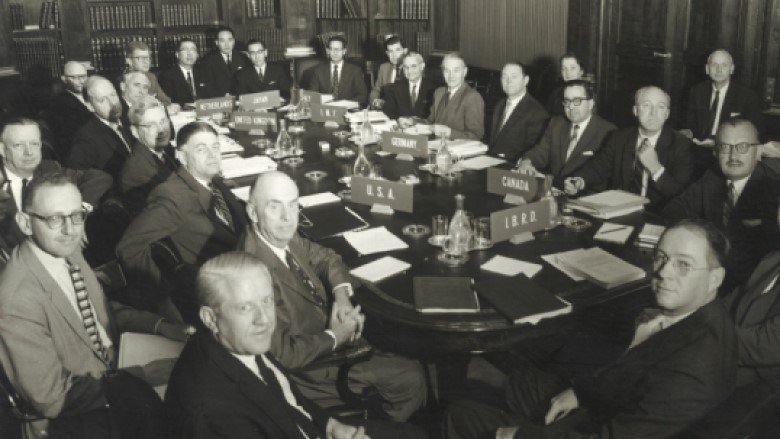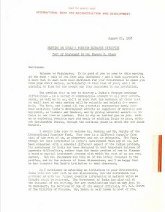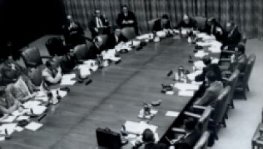First steps towards a solution
Delegates discussed a report on the economic position and prospects of India prepared by Bank Group staff, based on information supplied by the Government of India. The group reached a consensus of views on India's economic situation and appropriate methods of resolving it. According to a 1968 memo on the history of the consortium, there was a shared recognition of the sizeable goals set by India in its five-year plan and a mutual desire to help complete the major projects successfully.
The Bank Group and other delegates indicated the amounts and type of financial aid they could pledge to meet the $350 million deficit India faced for the rest of the fiscal year to March 1959, as well as potential figures for the remainder of the second plan. The form and type of aid would be further negotiated in bilateral consultations between India and the aid-providing country.
Continuing commitment to India
The second consortium, held March 16-17, 1959, reviewed developments in the Indian economy since the first meeting. It was concluded that India could reasonably expect to maintain the momentum of its development program without straining its external reserves. The participants also confirmed their interest in assisting India with the successful completion of its plan.
The consortium continued to meet twice annually. By the end of 1960, the group was referred to as the India Consortium, or Aid-India Consortium Group. Its purpose had shifted from providing emergency financial aid to coordinating long-term financing to India's development plan. The consortium's membership expanded to include representatives from France, Austria, Italy, the Netherlands and Belgium, and the International Development Association (IDA), the newly established arm of the Bank Group financing economic growth of Part II member countries through concessional loans or grants.
A new coordinating mechanism
The consortium model sparked the interest of several member countries. The Pakistan Consortium was formed in October 1960 and requests for the Bank Group to organize aid groups followed from the governments of Nigeria, Sudan, Tunisia, and Colombia.
The Bank Group and its Part I members engaged in discussions and recommended that a "consultative group" was the appropriate mechanism for supporting each of the countries. A consultative group was established as a forum for donors and recipients to exchange information, assess development performance and policy, and discuss financial assistance without the expectation of firm pledges to fill a needed gap, as in the case of the consortia.
The role of the Bank Group and consortium final chapter
The Bank Group's Department of Operations (1957-1965), and succeeding regional unit staff who continued the function after 1965, provided economic analysis and reports for discussion at consortium meetings, supplied balance of payments and other financial data to the Indian government, monitored the progress of development, and provided secretariat support and meeting documentation. The Secretary's Department of the Bank Group took over secretariat support in 1963.
While the India Consortium had, by 2000, outlived its usefulness, it had paved the way for the Bank Group's leadership in coordinating development assistance for over forty countries for four decades.
Archival records and knowledge products related to India Consortium
The inventories of India Consortium records are found below and contain lists of related records primarily organized by office of origin. Records are found in various locations, or “fonds,” in the holdings of the World Bank Group Archives. Most archival records related to the India Consortium originate in the South Asia Regional Vice Presidency (SAR) fonds. Records include correspondence between Bank Group senior staff, government officials, and consortium members, minutes of meetings that occurred between consortium meetings, Bank-Group-authored or government-authored economic reports and policy papers, financial data tables, and meeting records.
As the secretariat unit from 1963 onwards, the Secretary's Department fonds contains official meeting records including notice of meeting, agenda, list of delegates, chairman's report of proceedings, participants' statements, closing remarks, press release, economic reports, and related correspondence. There is some overlap of meeting documentation between Secretary's Department and SAR as both the units kept these records over time.
Other archival records including the Economic Committee papers on the consortium are not yet arranged and described. The papers of Bank Group staff Bernard R. Bell, who led a study of India's Fourth Five-Year Plan, contains his letters, memoranda, and copies of consortium meeting records. You will also find sound recordings of consortium meetings produced by the Bank Group's communications unit in the Office of External Relations fonds.
Many of the textual records have been declassified and a portion are digitized. Hyperlinks to the digitized material are included where available.
We invite you to explore other knowledge products produced by the Archives starting with the first consortium meeting featured in the World Bank Group Historical Timeline. In addition, first-hand experiences of Bank Group personnel with knowledge of or participation in the consortia and early consultative groups are found in the oral history interviews of J. Burke Knapp, Bernard R. Bell, William Diamond, and Roger Chaufournier.
We also encourage you to browse the Archives Photo Catalog for digitized images related to the consortium or search the Documents & Reports database for official Bank Group reports and press releases.






